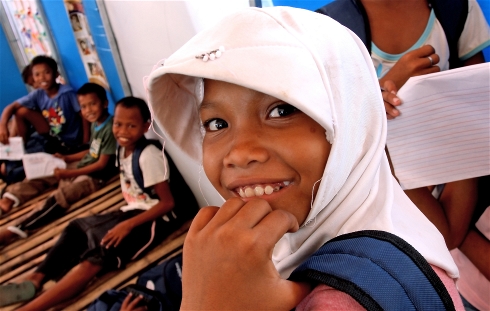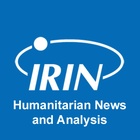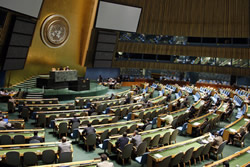In crowded Philippine IDP camp, children learn to smile again
In crowded Philippine IDP camp, children learn to smile again
ZAMBOANGA, 19 November 2013 (IRIN) – Two months after renegade Muslim militants opposed to efforts by the Philippine government to end a decades-long rebellion laid siege to the southern city of Zamboanga, traumatized children are learning to laugh again.

The Moro National Liberation Front (MNLF) attacked several villages in Zamboanga city, a major port in the Mindanao region that is home to about a million people. The attack was apparently carried out to sabotage peace talks between the government and a splinter group aimed at putting a stop to decades of insurgency that has left an estimated 150,000 people dead and plunged the mineral-rich south into deep poverty.
The MNLF signed a peace deal with Manila in 1996, under which an autonomous region was set up in the south. A portion of the MNLF rebel forces were integrated into the government security forces, but many other militants did not surrender their arms and went back into the hills.
Despite the millions of dollars in development aid poured into the predominantly Muslim region, it has remained hobbled by poverty, with the former rebel leaders turning into corrupt bureaucrats. The President of the Philippines, Benigno Aquino, who won a six-year term in 2010, declared the autonomous region a “failed experiment” and subsequently signed a framework agreement with an MNLF splinter group, the Moro Islamic Liberation Front (MILF), to create a new political entity instead of the old autonomous region.
The siege in Zamboanga left over 200 rebels, security force members and civilians dead. It also displaced more than 120,000 people, nearly half of them children, who were traumatized by the intense urban fighting.
Many of these children are now housed in squalid, overcrowded evacuation centres, where they are vulnerable to abuse. There have been reports of sexual assault against children, and of youngsters being bullied by adults. Many children are in need of psycho-social care and bear deep emotional scars after their harrowing experiences.
Financial support from the UN Central Emergency Response Fund (CERF) to the UN Children’s Fund (UNICEF) has greatly helped to ease the children’s suffering, and the agency’s implementing partner, Community and Family Services International (CFSI), has been able to help restore a semblance of normality to lives disrupted by conflict.
Among the flagship initiatives are the creation of “child-friendly spaces” that double as temporary classrooms where children can play, interact and learn. Volunteers not only teach them academic subjects, but also instruct them on safety issues, what their rights are, and how they can protect themselves. In these safe spaces children are learning to trust again and, best of all, to smile and laugh again.
By Jason Gutierez
IRIN
###
About the Integrated Regional Information Networks (IRIN)
IRIN – standing for Integrated Regional Information Networks – has its head office in Nairobi, Kenya, with regional desks in Nairobi, Johannesburg, Dakar, Dubai and Bangkok, covering some 70 countries. The bureaus are supported by a network of local correspondents, an increasing rarity in mainstream newsgathering today.
IRIN is an award-winning humanitarian news and analysis service covering the parts of the world often under-reported, misunderstood or ignored.
It delivers unique reporting from the frontlines of humanitarian action to over a million online readers.
IRIN helps make a difference in three key ways:
▪ Humanitarian decision-makers better allocate resources
▪ Relief workers are better informed
▪ Media and the general public become aware and engaged
IRIN’s editorial team bring a huge range of experience, diversity and multimedia skills to bear – with a product range that spans text, film, photography and hard-copy publications.
IRIN is a remarkable success which, with strong donor support, has defined and successfully occupied a unique niche. By listening to its readers, it continues to evolve and contribute to better-informed and more effective humanitarian action.

###
About the United Nations Office for the Coordination of Humanitarian Affairs (OCHA)
OCHA is the part of the United Nations Secretariat responsible for bringing together humanitarian actors to ensure a coherent response to emergencies. OCHA also ensures there is a framework within which each actor can contribute to the overall response effort.
OCHA’s mission is to:
- Mobilize and coordinate effective and principled humanitarian action in partnership with national and international actors in order to alleviate human suffering in disasters and emergencies.
- Advocate the rights of people in need.
- Promote preparedness and prevention.
- Facilitate sustainable solutions.
How we deliver
OCHA’s Strategic Framework ensures that OCHA delivers on its core mandate, while responding to contemporary global challenges. The three pillars of the Strategic Framework are:
1. Partnerships: broadening the coalition for multilateral humanitarian action
The scale and scope of global challenges requires working together in new ways, with new partners. Partnership has always been integral to OCHA’s efforts. Sustained relations, built on trust and mutual respect, are vital when preparing for and responding to humanitarian emergencies. OCHA has a unique position within the international humanitarian system to convene and influence agendas. We will do this more strategically, with the aim of creating a more enabling environment for humanitarian action.
2. Service provider: building a better system
The expectations of OCHA have evolved since humanitarian reform. We will ensure that our services and support to partners also evolve and meet clients’ needs. We are focused on helping partners more predictably through humanitarian coordination leadership, strengthening coordination mechanisms, and improving the evidence base for humanitarian decision-making, planning and resource allocation.
3. Reliability and professionalism: creating better staffing and surge solutions to be there when it counts
In 2010, OCHA will introduce surge solutions to ensure the right people are on the ground immediately after a new disaster. This will be coordinated with longer-term staffing to ensure continuity of OCHA presence.
OCHA people
OCHA is its people. From 35 offices around the world, some 1,900 specialized and dedicated OCHA staff work to ensure that effective assistance reaches millions of humanitarian beneficiaries in four continents.

###
> United Nations (UN).
 The United Nations was established on 24 October 1945 by 51 countries committed to preserving peace through international cooperation and collective security. Today, nearly every nation in the world belongs to the UN: membership totals 192 countries.
The United Nations was established on 24 October 1945 by 51 countries committed to preserving peace through international cooperation and collective security. Today, nearly every nation in the world belongs to the UN: membership totals 192 countries.
When States become Members of the United Nations, they agree to accept the obligations of the UN Charter, an international treaty that sets out basic principles of international relations. According to the Charter, the UN has four purposes:
- to maintain international peace and security;
- to develop friendly relations among nations;
- to cooperate in solving international problems and in promoting respect for human rights;
- and to be a centre for harmonizing the actions of nations.
###
* The above story is adapted from materials provided by United Nations (UN)
** More information at United Nations (UN)




















